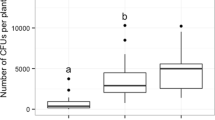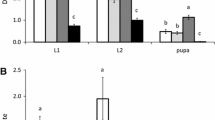Abstract
In choice test experiments on strawberry leaf disc arenas the phytoseiid mites Neoseiulus californicus and N. cucumeris were more effective than Typhlodromus pyri as predators of the phytophagous mites Tetranychus urticae and Phytonemus pallidus. There were no preferences shown for either prey by any of these predators. In multiple predator leaf disc experiments both Phytoseiulus persimilis and N. cucumeris significantly reduced numbers of T. urticae eggs and active stages; this effect was seen when the two species were present alone or in combination with other predator species. Neoseiulus californicus was less effective at reducing T. urticae numbers, and T. pyri was not effective; no interaction between predator species was detected in these experiments. When T. urticae alone was present as prey on potted plants, P. persimilis and N. californicus were the only phytoseiids to significantly reduce T. urticae numbers. These two predator species provided effective control of T. urticae when P. pallidus was also present; however, none of the predators reduced numbers of P. pallidus. There were no significant negative interactions when different species of predators were present together on these potted plants. In field experiments, releases of both P. persimilis and N. cucumeris significantly reduced T. urticae numbers. However, there was a significant interaction between these predator species, leading to poorer control of T. urticae when both species were released together. These results show the importance of conducting predator/prey feeding tests at different spatial scales.
Similar content being viewed by others
References
Barber A, Campbell CAM, Crane H, Lilley R, Tregidga E (2003) Biocontrol of two-spotted spider mite Tetranychus urticae on dwarf hops by the phytoseiid mites Phytoseiulus persimilis and Neoseiulus californicus. Biocontrol Sci Techn 13:275–284
Butcher MR, Penman DR, Scott RR (1987) The relationship between two-spotted spider mite and strawberry yield in Canterbury. New Zealand J Exp Agric 15:367–370
Croft BA, Pratt PD, Koskela G, Kaufman D (1998a) Predation, reproduction and impact of phytoseiid mites (Acari:Phytoseiidae) on cyclamen mite (Acari:Tarsonemidae) on strawberry. J Econ Entomol 91:1307–1314
Croft BA, McMurtry JA, Luh H (1998b) Do literature records of predation reflect food specialisation among species and predation types of phytoseiid mites (Acari:Phytoseiidae)? Exp Appl Acarol 22:467–480
Cross JV, Easterbrook MA, Crook AM, Crook D, Fitzgerald JD, Innocenzi PJ, Jay CN, Solomon MG (2001) Biocontrol of pests of strawberry in Northern and Central Europe. Biocontrol Sci Techn 11:165–216
Easterbrook MA (1992) The possibilities for control of two-spotted spider mite Tetranychus urticae on field-grown strawberries in the UK by predatory mites. Biocontrol Sci Techn 2:235–245
Easterbrook MA (1998) The beneficial fauna of strawberry fields in the south-east of England. J Hort Sci Biotech 73:137–144
Easterbrook MA, Fitzgerald JD, Solomon MG (2001) Biological control of strawberry tarsonemid mite Phytonemus pallidus and two-spotted spider mite Tetranychus urticae on strawberry in the UK using species of Neoseiulus (Amblyseius) (Acari: Phytoseiidae). Exp Appl Acarol 25:25–36
Easterbrook MA, Fitzgerald JD, Pinch C, Tooley J, Xu X-M (2003) Development times and fecundity of three important arthropod pests of strawberry in the UK. Ann Appl Biol 143:325–331
Fitzgerald JD, Easterbrook MA (2003) Phytoseiids for control of spider mite, Tetranychus urticae and tarsonemid mite, Phytonemus pallidus, on strawberry in UK. IOBC/WPRS Bull 26(2):107–111
Hadam JJ, Aliniazee MT, Croft BA (1986) Phytoseiid mites of major crops in Willamette Valley, Oregon, and pesticide resistance in Typhlodromus pyri Scheuten. Environ Entomol 15:1255–1263
Hatherly IS, Bale JS, Walters KFA (2005) Intraguild predation and feeding preferences in three species of phytoseiid mite used for biological control. Exp Appl Acarol 37:43–55
Jacobson RJ, Croft P, Fenlon J (2001) Suppressing establishment of Frankliniella occidentalis Pergande (Thysanoptera:Thripidae) in cucumber crops by prophylactic release of Amblyseius cucumeris Oudemans (Acarina:Phytoseiidae). Biocontrol Sci Techn 11:27–34
Janssen A, Pallini A, Venzon M, Sabelis MW (1998) Behaviour and indirect interactions in food webs of plant-inhabiting arthropods. Exp Appl Acarol 22:497–521
Jolly RL (2001) The status of the predatory mite Neoseiulus californicus (McGregor) (Acari:Phytoseiidae) in the UK, and its potential as a biocontrol agent of Panonychus ulmi (Koch) (Acari:Tetranychidae). PhD thesis. University of Birmingham. 173 pp
McMurtry JA, Croft BA (1997) Life-styles of phytoseiid mites and their role in biological control. Ann Rev Entomol 42:291–321
Overmeer WPJ (1985) Rearing and handling. In: Helle W, Sabelis MW (eds) Spider mites, their biology, natural enemies and control, vol B. Elsevier, Amsterdam, pp 161–169
Roda A, Nyrop J, Dicke M, English-Loeb G (2000) Trichomes and spider-mite webbing protect predatory mite eggs from intraguild predation. Oecologia 125:428–435
Rhodes EM, Liburd OE, Kelts C, Rondon SI, Francis RR (2006) Comparison of single and combination treatments of Phytoseiulus persimilis, Neoseiulus californicus and Acramite (bifenazate) for control of twospotted spider mites in strawberries. Exp Appl Acarol 39:213–225
Rosenheim JA (1998) Higher-order predators and the regulation of insect herbivore populations. Ann Rev Entomol 43:421–447
Rosenheim JA, Kaya HK, Ehler LE, Marois JJ, Jaffee BA (1995) Intraguild predation among biological control agents-theory and evidence. Biol Contr 5:303–335
Sances FV, Toscano NC, Lapre LF, Oatman ER, Johnson MW (1982) Spider mites can reduce strawberry yields. Calif Agric 36:15–16
Sih A, Crowley P, McPeek M, Petranka J, Strohmeier K (1985) Predation, competition, and prey communities: a review of field experiments. Ann Rev Ecol Syst 16:269–311
Stenseth C, Nordby A (1976) Damage and control of the strawberry mite, Stenotarsonemus pallidus (Acarina:Tarsonemidae), on strawberries. J Hort Sci 51:49–54
Walzer A, Schausberger P (1999) Predation preferences and discrimination between con- and heterospecific prey by the phytoseiid mites Phytoseiulus persimilis and Neoseiulus californicus. BioControl 43:469–478
Walzer A, Blumel S, Schausberger P (2001) Population dynamics of interacting predatory mites, Phytoseiulus persimilis and Neoseiulus californicus, held on detached bean leaves. Exp Appl Acarol 25:731–743
Yao DS, Chant DA (1989) Population growth and predation interference between two species of predatory phytoseiid mites (Acarina:Phytoseiidae) in interactive systems. Oecologia 80:443–455
Zacharda M, Hluchy M (1997) Biological control of the two-spotted mite Tetranychus urticae on strawberries by the predatory phytoseiid mite Typhlodromus pyri (Acari, Tetranychidae, Phytoseiidae). Exp Appl Acarol 20:83–94
Zalom FG, Pickel C, Welch NC (1990) Recent trends in strawberry arthropod management for coastal areas of the western United States. In: Bostanian NJ, Wilson LT, Dennehy TJ (eds) Monitoring and integrated management of arthropod pests of small fruit crops. Intercept, Andover, pp 239–259
Zemek R, Prenerova E (1997) Powdery mildew (Ascomycotina:Erysiphales)—an alternative food for the predatory mite Typhlodromus pyri Scheuten (Acari: Phytoseiidae). Exp Appl Acarol 21:405–414
Zhang Z-G, Croft BA (1995) Interspecific competition and predation between immature Amblyseius fallacis, Amblyseius andersoni, Typhlodromus occidentalis and Typhlodromus pyri (Acari:Phytoseiidae). Exp Appl Acarol 19:247–257
Acknowledgements
This work was funded by the UK Department for Environment, Food and Rural Affairs (Defra). We thank Gillian Arnold for statistical analysis, and Xiangming Xu for useful discussions.
Author information
Authors and Affiliations
Corresponding author
Rights and permissions
About this article
Cite this article
Fitzgerald, J., Pepper, N., Easterbrook, M. et al. Interactions among phytophagous mites, and introduced and naturally occurring predatory mites, on strawberry in the UK. Exp Appl Acarol 43, 33–47 (2007). https://doi.org/10.1007/s10493-007-9094-x
Received:
Accepted:
Published:
Issue Date:
DOI: https://doi.org/10.1007/s10493-007-9094-x




